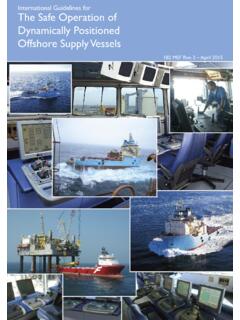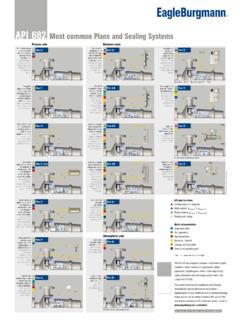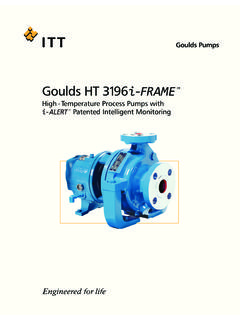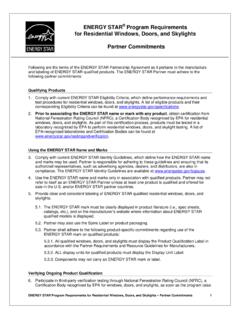Transcription of BULK HOSE BEST PRACTICE GUIDELINES
1 BULK HOSE BEST PRACTICE GUIDELINES - 2 -CONTENTS ABBREVIATIONS 3 INTRODUCTION 4 GENERAL REQUIREMENTS 5 INSTALLATION PROCEDURES 6 RECOMMENDED CONTENT OF PROCEDURES 6 TRANSFER HOSES 9 HOSE COMPONENTS AND CONSTRUCTION 9 HOSE STRING 10 REPLACING SECTIONS OF HOSES IN A STRING 11 RECOMMENDED FLOATATION COLLARS FOR BUNKERING HOSE STRINGS 12 WEEKLY INSPECTIONS
2 13 AFTER STORMS 14 VISUAL INSPECTION PRE AND POST USE 15 GENERAL PLATFORM ALARM (GPA) 15 VESSEL APPROACHING LOCATION 15 POLLUTION SAFETY 16 GUIDANCE ON BULK HOSE OPERATIONS 16 RECENT DEVELOPMENT IN HANDLING BULK HOSES 17 PRE-BUNKERING CHECKLIST 21
3 BENEFITS 22 ACKNOWLEDGEMENTS 24 - 3 -ABBREVIATIONS BOSVA British Offshore Support Vessel Association COSHH Control of Substances Hazardous to Health EMS Electronic Maintenance System EPDM Ethylene Propylene Diene-Terpolymer GPA General Platform Alarm ID Identification LOLER Lifting Operations Lifting Equipment Regulations NWEA North West European Area GUIDELINES O&G UK Oil & Gas UK OIM Offshore Installation Manager PMR Planned Maintenance Routine PSS Platform Services Supervisor SOPEP Shipboard Oil Pollution Emergency Plans STL Services Team Leader SWL Safe Working Load - 4 -INTRODUCTION Background Integra is an initiative that was established by Sparrows and Sigma 3 in 2006 to deliver best practices in crane and deck operations in the offshore industry.
4 It was quickly realised during their offshore visits that there was a need to produce guidance to manage bulk hose systems safely and at the same time create a common PRACTICE throughout the industry. The key elements required in coaching personnel to recognise and eliminate hazardous risks to themselves and others are contained within management systems. These systems eliminate damage to plant and equipment, providing safer operations and stricter controls of environmental issues. We recognised minimum standards of controls and guidance are in place to manage and maintain bulk hose systems, including hose hang-off points on installation structures. We also acknowledged the difficulties in being prescriptive due to the differences in installation layouts and working practices.
5 To make positive changes in our operations we have collated information from the workforce on how to manage work involving bulk hose systems. The following GUIDELINES indicate best practices which will reduce the number of hose failure incidents in the industry and the resulting exposure to the environment. Environmental Issues With the evidence available it was identified that 21% of spills to the sea were hose related incidents. The most common bulk hose failures are due to abrasion to the outer cover of the hoses rubbing on the installation structures, resulting in leakage from the hose string. The wear on the hose is accelerated when the hose radius exceeds the recommended minimum bend radius criteria causing premature failure.
6 Both examples can cause the hose to leak into the sea if not controlled by a robust hose management system. All environmentally sensitive products should have suitable hose connections or similar self sealing connection on the hose end. - 5 -GENERAL REQUIREMENTS The following recommendations apply to any hose which carries products, including products that are harmful to the environment if containment is lost. It is recommended by hose manufacturers, based on information taken from previous incidents on installations that a bulk hose should be changed out approximately every two years due to internal fatigue to the hose layers. When the hose is not in use an end cap, commonly known as a blank, should be used on the connection that marries the hose to the vessel manifold, and where possible protect the hose ends with a waterproof cover preventing contamination, corrosion or damage to the hose connection.
7 When hose strings are suspended from the installation, they should be suspended well clear of the sea and restrained to the installation minimising movement and abrasion to the hoses outer cover, preventing the waves from twisting the hoses. Where the hose may contact any part of the installation structures all contact points on the hose should be covered with a form of protection. Floatation collars can be used or alternatively, sections of redundant hose can be fitted to the structures at impact abrasion points. Floatation collars should be used either side of the hose couplings to prevent the coupling damaging an adjacent hose in the fingers. To prevent excessive load on a suspended hose string, the hose should be drained back to the vessel or installation once offloading is completed.
8 Hoses should be suspended from sound structures or certified lifting/hang-off points on the installation to prevent kinking in the hose string. If required the LOLER Competent Person or equivalent, or structural engineer, should be consulted for guidance. Hoses should never be suspended or supported by wire slings as they may cut into the hose and damage the hose structure. The LOLER Competent Person should be consulted for selection of correctly certified and appropriate slings. When replacing a length of hose in a string, the string must be brought in board and barriers erected round the hose indicating no unauthorised entry during the replacement of the hose and/or floatation collars. Once a hammer lug union is installed and tightened it should be marked across both faces with paint or similar permanent marker to monitor the fitting is continually taut and fit for purpose.
9 Care should be taken when using cutting tools to remove packaging from a new hose. It is imperative that no damage comes to the hose section during unpacking. Prior to commencing any offloading operations the hose string should be visually inspected for damage using the list below as a minimum check: Leaks at the hose fitting or in the hose make up Damaged, cut or abraded covers Exposure of reinforcement wires from the hose material Signs of kinked, cracked, crushed, flattened or twisted areas in the hose sections Hose ends degraded, pitted or badly corroded at the fittings Identify sufficient numbers of floatation collars are on the hose string - 6 - On completion of bunkering operations the hose should be re-examined for any damage that may have occurred during the transfer operation INSTALLATION PROCEDURES Documents should be in place clearly specifying how the site will control the maintenance and inspection of all bunkering hose strings and associated equipment lifting equipment and support mountings.
10 This document should be approved by the relevant Technical Department and entered into their pertinent system for review as per the Company Procedures. The appointed system owner is responsible for ensuring all relevant persons know of and understand the procedure. It is recommended a competent/responsible person carries out frequent lifting equipment audits to confirm this. RECOMMENDED CONTENT OF PROCEDURES The system owner should indicate who is responsible for ensuring the procedure is being adhered to and act as focal point on all matters relating to bulk hoses maintenance and inspection. On locations where bunkering of drilling products takes place, an interface should exist with the Drilling Department and Operations Departments where responsibilities are clearly defined, documented and agreed who is responsible for inspection and change-out of drilling product hose assemblies.






